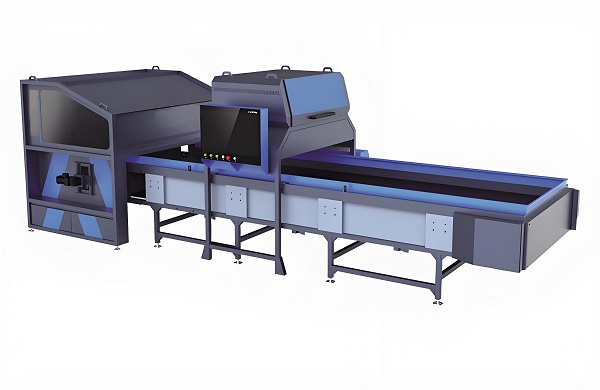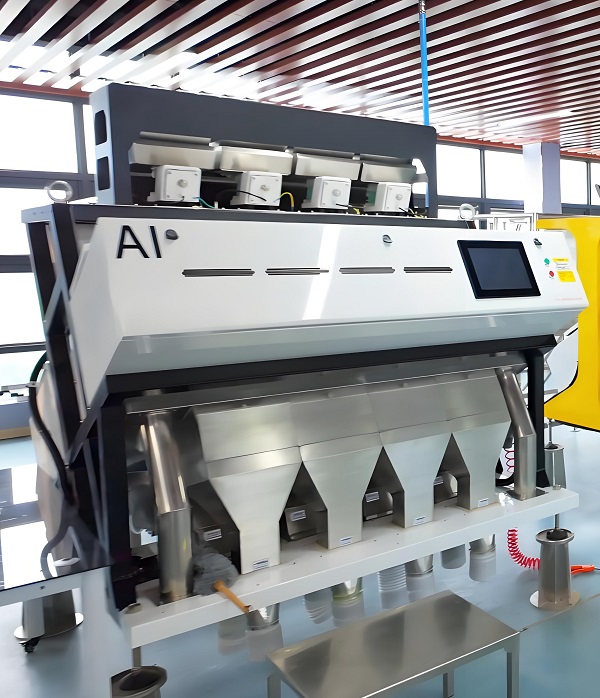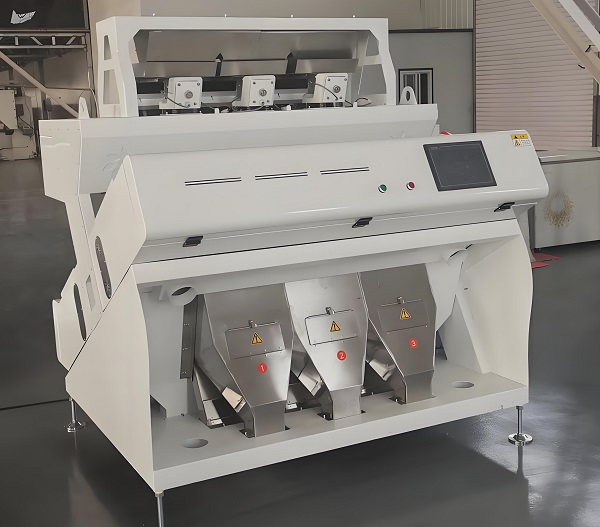Preface: Optical sorter is an extremely efficient and accurate equipment in the modern waste treatment and resource recycling industry. With its unique working principle and advanced technical structure, it can achieve excellent waste sorting function while running at high speed, which has greatly promoted the development of the waste recycling industry and played an important role in achieving the goal of waste sorting. The following is a detailed introduction to the optical sorter.
A. Basic concept of optical sorter

Optical Sorter
As the name suggests, the optical sorter is a device that uses optical principles to sort materials. It captures the optical properties of materials, such as reflection, transmission or absorption characteristics, through optical sensors, and uses these characteristics to classify materials. Optical sorters are widely used in many fields such as resource recycling and food processing, and have won wide recognition in the market for their efficient and accurate sorting capabilities.
B. Working principle of optical sorter
The working principle of the optical sorter is based on the difference in the reflection, transmission or absorption characteristics of materials to light. When mixed materials pass through the optical sorter, the equipment uses a high-resolution camera or spectral sensor to capture the image or spectral information of the material, and analyzes and processes it through a computer system. According to the recognition results, the actuator (such as a robotic arm, air jet device, etc.) will respond quickly to separate different types of materials.
Specifically, the working process of the optical sorter can be divided into the following steps:
1. Material input: The mixed material is input into the optical sorter equipment through the conveyor belt. The conveyor belt runs at a certain speed to ensure that the material can pass through the optical sorting area evenly and continuously.
2. Optical capture: The optical sensor (such as a camera or spectrometer) located above the conveyor belt begins to capture the image or spectral information of the material. These sensors can record the optical properties of the material with high precision and provide basic data for subsequent analysis and processing.
3. Data analysis: The captured image or spectral information is transmitted to the computer system for analysis and processing. The computer system uses preset algorithms and models to identify and classify materials. These algorithms and models are usually built based on a large amount of experimental data and machine learning technology, and can accurately identify different types of materials.
4. Execution sorting: According to the results of the analysis and processing, the actuator responds quickly. For recyclable materials, such as metals, plastics, etc., the actuator may separate them from the conveyor belt through electromagnetic adsorption, airflow injection, etc., and send them to the corresponding collection container. For non-recyclable materials, they continue to move along the conveyor belt for subsequent processing.
C. Types and characteristics of optical sorters

Optical Sorter
Optical sorters can be divided into many types according to their working principles and technical characteristics, and each type has its own unique application scenarios and advantages.
1. NIR optical sorter (near infrared spectroscopy analysis principle)
Working principle: NIR optical sorter uses a near infrared spectrometer to capture the spectral information of materials and identifies the type of materials by analyzing this information. Near infrared spectrometers can record the absorption and reflection characteristics of materials at different wavelengths, thereby revealing the chemical composition and structural information of materials.
Application scenarios: NIR optical sorters are widely used in the food industry, wood processing industry, and resource recycling industry. In the food industry, it can be used to remove fruits, grains, etc. that do not meet the requirements for size and color; in the wood processing industry, it can be used to identify the type and quality of wood; in the resource recycling industry, it can be used to recycle recyclable materials such as wood and plastic bottles.
2. VIS color sorter (generally with high-resolution CCD lens to identify color and shape)
Working principle: VIS color sorter uses a high-resolution CCD lens to capture the color and shape information of materials and identifies the type of materials by analyzing this information. CCD lens can record the color distribution and shape characteristics of materials with high precision, providing basic data for subsequent classification and processing.
Application scenario: VIS color sorter is mainly used in the food industry, plastic recycling industry, etc. In the food industry, it can be used to remove grains, fruits, etc. whose colors do not meet the requirements; in the plastic recycling industry, it can be used to separate plastic bottles of different colors, etc.
3. Metal optical sorter (X-ray principle)
Working principle: The metal optical sorter uses an X-ray detector to capture the X-ray image of the material and identifies the type of material by analyzing these images. X-rays can penetrate the material and record its internal structural information, thereby revealing the composition and density of the material.
Application scenario: Metal optical sorter is mainly used in the metal recycling industry and the field of material processing containing metal impurities. It can be used to recycle expensive metals such as stainless steel, aluminum, copper, and effectively remove metal impurities in the material.
In addition, the optical sorter also has the following characteristics:
High efficiency: The optical sorter can process a large amount of material at a very fast speed, with a processing capacity of several tons or even tens of tons per hour. This greatly improves production efficiency and reduces labor costs.
Accuracy: The optical sorter uses advanced optical technology and algorithms to identify and classify materials with an accuracy rate of more than 90%. This ensures the effective recycling and utilization of materials, reducing resource waste and environmental pollution.
Flexibility: The optical sorter can be customized and adjusted according to different application scenarios and needs. For example, the sensitivity and recognition algorithm of the sensor can be adjusted to adapt to different types of materials; different actuators can be replaced to achieve different sorting methods, etc.
D. Application fields of optical sorters
The optical sorter has been widely used in many fields with its efficient and accurate sorting capabilities.
1. Resource recycling industry: The optical sorter is one of the key equipment in the resource recycling industry. It can be used to recycle recyclable materials such as wood, glass, and plastic bottles; it can also be used to recycle expensive metals such as stainless steel, aluminum, and copper. This helps to reduce the amount of landfill and the pollution caused by incineration, and promote the recycling and sustainable development of resources.
2. Food industry: The optical sorter is also widely used in the food industry. It can be used to remove fruits and grains that do not meet the requirements of size and color; it can also be used to sort vegetables and fruits and remove vegetables that do not contain chlorophyll. This helps to improve the quality and safety of food and meet the needs of consumers.
3. Other fields: In addition to the resource recycling industry and the food industry, optical sorters can also be used in mining, chemical industry and other fields. In the mining industry, it can be used for the sorting and purification of ore; in the chemical industry, it can be used for the screening and classification of raw materials, etc.
E. Development trends and challenges of optical sorters

Optical Sorter
With the advancement of science and technology and the improvement of environmental awareness, the application prospects of optical sorters in the fields of garbage disposal and resource recycling are becoming more and more broad. However, the development of optical sorters also faces some challenges and problems.
a. Technology development trends:
1. Intelligence: With the continuous development of artificial intelligence technology, optical sorters will pay more attention to intelligence and automation. For example, using deep learning algorithms to improve the accuracy and efficiency of material identification; using robotics technology to realize automatic grasping and classification of materials, etc. This will further improve the performance and efficiency of optical sorters and reduce labor costs.
2. Multifunctionality: In order to meet different application scenarios and needs, optical sorters will develop in the direction of multifunctionality. For example, developing sensors and actuators that can simultaneously identify multiple materials; realizing functions such as automatic packaging and transportation of materials. This will improve the adaptability and flexibility of optical sorting machines and meet the needs of more fields.
3. Environmental protection and energy saving: With the improvement of environmental awareness, optical sorting machines will pay more attention to environmental protection and energy saving. For example, adopt low-power sensors and actuators; optimize the structure and operation mode of the equipment to reduce energy consumption and emissions, etc. This will help promote the sustainable development and wide application of optical sorting machines.
b. Challenges faced:
1. Technical bottlenecks: Although optical sorting machines have made significant progress and achievements, there are still some technical bottlenecks that need to be broken through. For example, how to improve the accuracy and efficiency of material identification; how to reduce the energy consumption and emissions of equipment, etc. This requires scientific researchers to continuously explore and innovate to promote the continuous development and improvement of optical sorting machine technology.
2. Market competition: With the continuous expansion of the optical sorting machine market and the intensification of competition, companies need to continuously improve the quality and performance of their products to win market share. At the same time, it is also necessary to pay attention to changes and trends in market demand, and adjust product strategies and production plans in a timely manner to meet customer needs.
3. Policy support: The government's policy support and guidance are crucial to the development of optical sorting machines. The government can introduce relevant policies and regulations to promote the development of the waste treatment and resource recycling industry; provide financial and technical support to encourage enterprises to carry out technological innovation and industrial upgrading, etc. This will help provide a good policy environment and market opportunities for the development of optical sorting machines.
PS: As one of the key equipment in the modern waste treatment and resource recycling industry, the optical sorting machine has won wide recognition in the market for its efficient and accurate sorting capabilities. With the advancement of science and technology and the improvement of environmental awareness, the development prospects of optical sorting machines are becoming more and more broad. However, the development of optical sorting machines also faces some challenges and problems, and scientific researchers need to continue to explore and innovate to promote the continuous development and improvement of their technology. At the same time, the government's policy support and guidance will also provide a good policy environment and market opportunities for the development of optical sorting machines. I believe that in the near future, optical sorting machines will play an important role in more fields and contribute to the sustainable development of mankind.
Save Time! Get A Detailed Quotation Quickly.
